Moorside Connections
Working with the Addingham Moorside community to create, restore and connect wildlife habitat & slow the flow.
As part of our Addingham4Becks project, in partnership with the Yorkshire Dales Rivers Trust (YDRT), Addingham Environment Group (AEG) is working in the upland parts of the parish in the Lumb Beck and Marchup catchments, on practical projects with Moorside landowners to help care for nature and create and connect new habitat.
Controlling Invasives
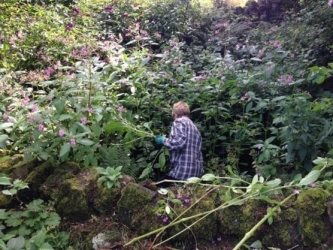
 Our volunteers have worked across the Lumb Beck catchment to remove Himalayan balsam, allowing native flora to flourish and reduce beckside soil erosion. We have also helped landowners to remove giant hogweed growing in several places in the catchment.
Our volunteers have worked across the Lumb Beck catchment to remove Himalayan balsam, allowing native flora to flourish and reduce beckside soil erosion. We have also helped landowners to remove giant hogweed growing in several places in the catchment.
Read more about our Himalayan Balsam Campaign here.
Addingham Moorside Tree & Hedge Planting
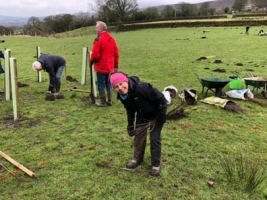
 In winter 2020 in the upper reaches of Lumb Beck catchment, the AEG volunteer labour-force helped three adjacent landowners to plant more than 1000 native trees and a new hedge alongside the beck. YDRT procured a grant from the Yorkshire Dales Millennium Trust and the Woodland Trust towards the cost of fencing, trees, and planting materials.
In winter 2020 in the upper reaches of Lumb Beck catchment, the AEG volunteer labour-force helped three adjacent landowners to plant more than 1000 native trees and a new hedge alongside the beck. YDRT procured a grant from the Yorkshire Dales Millennium Trust and the Woodland Trust towards the cost of fencing, trees, and planting materials.
Beck House Farm: daylighting headwater culverts & creating new wetland habitat
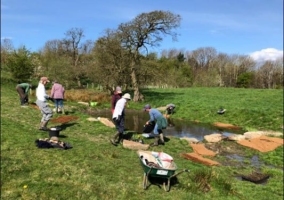
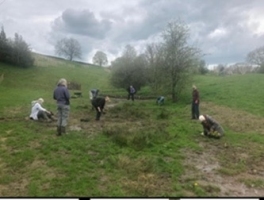 In Spring 2022, AEG applied for and secured a grant from Yorkshire Water’s Biodiversity fund, to help the landowner, Jill Feenan, continued her work uncovering deep drains and culverts to daylight a headwater and create more diverse wetland habitat, with ponds and leaky dams.
In Spring 2022, AEG applied for and secured a grant from Yorkshire Water’s Biodiversity fund, to help the landowner, Jill Feenan, continued her work uncovering deep drains and culverts to daylight a headwater and create more diverse wetland habitat, with ponds and leaky dams.
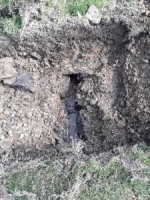 The grant paid for a local contractor to dig out the drains and for the purchase of pond and wetland plants. AEG and Yorkshire Rewilding volunteers joined forces to plant up the ponds and margins of the watercourse.
The grant paid for a local contractor to dig out the drains and for the purchase of pond and wetland plants. AEG and Yorkshire Rewilding volunteers joined forces to plant up the ponds and margins of the watercourse.
Users of The Dales High Way footpath, which crosses this land, are encouraged to stop awhile, explore and enjoy the new habitat that Jill is creating. She is part of the Yorkshire Rewilding Network
Lumb Ghyll Wood – Beckside Fencing

 With the agreement of the landowner, plus donations to AEG and a Bradford Council Climate Action grant, we have protected a section of Lumb Beck from soil erosion and nutrient pollution, caused by livestock coming down to the beck to drink. Fencing off the beck side between two fenced sections of Lumb Ghyll Wood, a West Yorkshire Local Wildlife Site, will allow the land to rewild with woodland ground flora. Alternative drinking water supplies are available in the field.
With the agreement of the landowner, plus donations to AEG and a Bradford Council Climate Action grant, we have protected a section of Lumb Beck from soil erosion and nutrient pollution, caused by livestock coming down to the beck to drink. Fencing off the beck side between two fenced sections of Lumb Ghyll Wood, a West Yorkshire Local Wildlife Site, will allow the land to rewild with woodland ground flora. Alternative drinking water supplies are available in the field.
A pedestrian gate has been added for the well-used public footpath and a stock gate in case the water supply to the field fails. Alongside the fencing works in Spring 2022, Bradford Council’s Countryside Service replaced the footbridge over the beck and with Friends of Ilkley Moor volunteers put in steps on the footpath on the steep slope above the beck making the climb easier for walkers and reducing soil erosion.
Lumb Beck Catchment Habitat Survey
With funding from Natural England’s Nature Recovery Network, YDRT in partnership with AEG commissioned ecologists from local consultancy, Haycock & Jay to do a field-by-field vegetation mapping survey of much of the Lumb Beck catchment. The survey took place in August 2021, and covered some 30 landholdings, large and small across the Moorside.
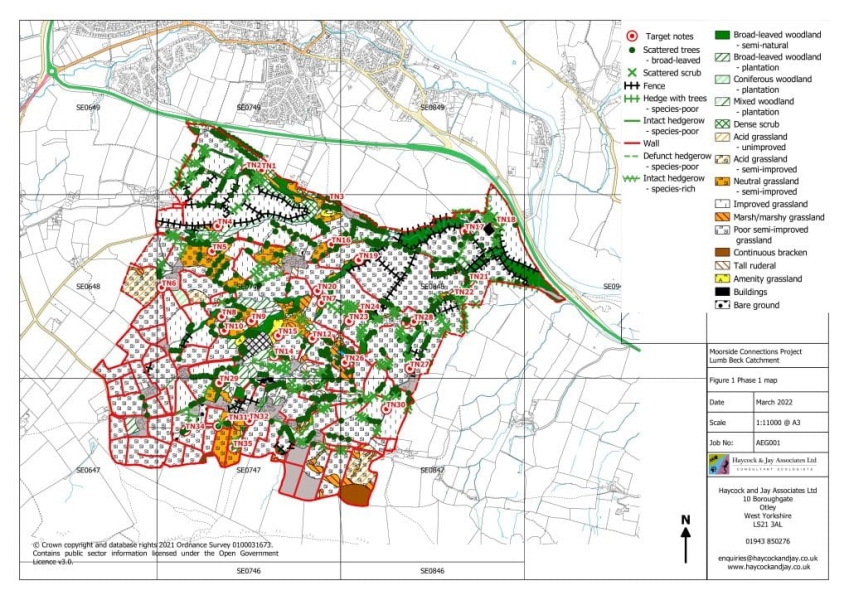
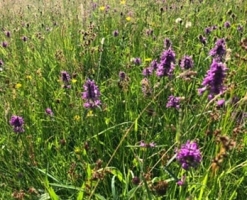
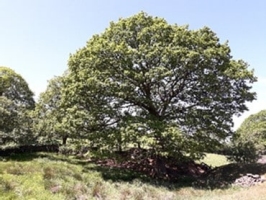 Whilst mapping the plant communities Haycock & Jay noted features of value for wildlife, such as veteran trees, ponds, areas of wildflower rich grassland, species-rich hedgerows and ghyll woodland.
Whilst mapping the plant communities Haycock & Jay noted features of value for wildlife, such as veteran trees, ponds, areas of wildflower rich grassland, species-rich hedgerows and ghyll woodland.
Haycock & Jay’s report highlighted opportunities for improving, protecting and better connecting habitat for wildlife across the catchment:
- Woodland & watercourse fencing – many of the watercourses in the catchment are well-wooded or have fine scattered deciduous trees. Not all are protected from livestock. By restricting stock access to the watercourses by providing drinking bays where necessary, the becks and woodlands can be protected from pollution, soil erosion and grazing damage.
- There are many opportunities to improve habitat connectivity through species rich hedgerow planting and restoration. Hedgerows have disappeared, have gaps or become reduced to just scattered hawthorn trees.
- Within the mainly species poor improved or semi-improved grassland, notable areas of species richness were found, including some hay meadows, areas of marshy grassland and steeper slopes where improvement has not happened These remnants show that changes in land management of the semi-improved grassland could result in an increase in wildflowers by, for example, spreading green hay or plug planting meadow species.
- Some areas, such as species poor grassland, may offer opportunities for tree planting and woodland creation, but great care will be needed to ensure nesting and foraging habitat for ground nesting birds such as curlew is not adversely affected.
Following the survey AEG is continuing to have conversations with individual landowners about habitat improvement opportunities on their land.
Tree & hedgerow planting in the headwaters of Marchup Beck
AEG has also helped with planting in the upper reaches of Marchup Beck.
At Lower Marchup Farm, the steep sides to the beck were fenced and planted with 500 native trees in 2021, using funding procured by the YDRT from the Environment Agency to provide new habitat for wildlife, improve water quality whilst increasing catchment roughness for natural flood management.
AEG volunteers contributed by removing and renovating redundant plastic tree guards for re-use on this planting scheme.

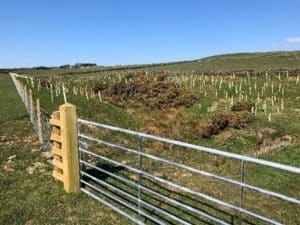

Marchup Heights
At Marchup Heights, AEG and landowner, Emma-Lou Fawcitt are working together to improve habitat for wildlife.
Tree and Hedge planting

 Our volunteers planted willow and alder to consolidate and protect the steep slopes of a watercourse, and to extend native hedgerows alongside the road boundary and around a newly completed equestrian arena. This planting will not only be important for storing carbon but with the use of native species and a mixture of hawthorn, blackthorn, holly and hazel in the hedges, will provide an excellent habitat for wildlife. Planting started in winter 2022 and is continuing in 2023 with a grant to the landowner from White Rose Forest.
Our volunteers planted willow and alder to consolidate and protect the steep slopes of a watercourse, and to extend native hedgerows alongside the road boundary and around a newly completed equestrian arena. This planting will not only be important for storing carbon but with the use of native species and a mixture of hawthorn, blackthorn, holly and hazel in the hedges, will provide an excellent habitat for wildlife. Planting started in winter 2022 and is continuing in 2023 with a grant to the landowner from White Rose Forest.
As there are ground nesting birds using the land, open grassland is needed against the moorland and so more extensive woodland planting on the holding was discounted.
Wildflower rich grassland & rushy pasture

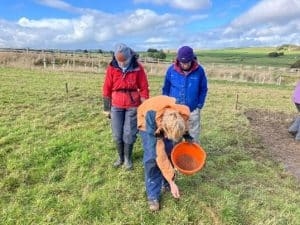 At the top of the holding, landowner Emma-Lou, has set aside an area of rough pasture and made-up ground for wildlife. In partnership with the Yorkshire Dales Millennium Trust we are helping create a more diverse grassland habitat to benefit pollinators and other insects and ground nesting birds.
At the top of the holding, landowner Emma-Lou, has set aside an area of rough pasture and made-up ground for wildlife. In partnership with the Yorkshire Dales Millennium Trust we are helping create a more diverse grassland habitat to benefit pollinators and other insects and ground nesting birds.
In October 2022 AEG volunteers worked with the YDRT BeeTogether Project Officer, to help prepare the ground and sow a wildflower seed mix.

